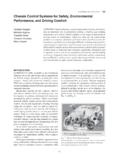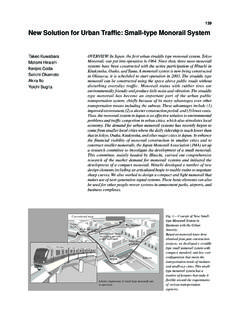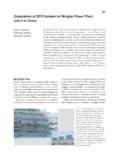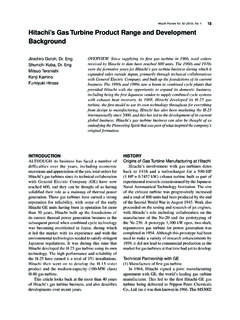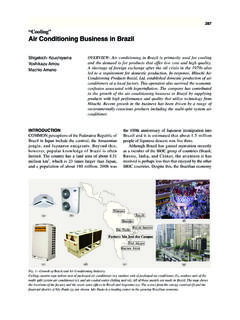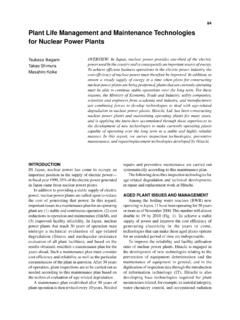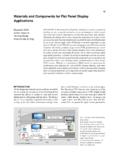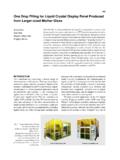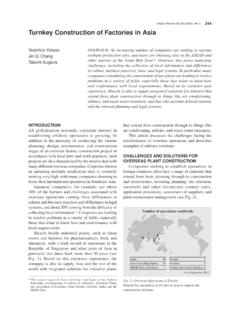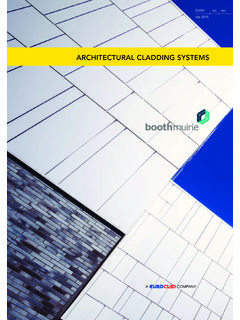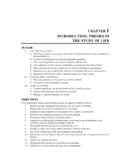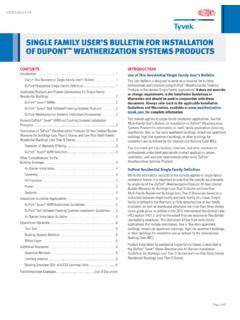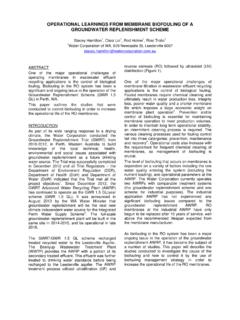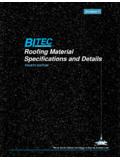Transcription of Highly Efficient Power Stations with Carbon Capture
1 Hitachi Review Vol. 59 (2010), No. 3 89 Highly Efficient Power Stations with Carbon CaptureChristian Bergins, Dr. Wu, Ph. a global technology and equipment provider for complete thermal Power plants, Hitachi is actively developing CO2 ( Carbon dioxide) Capture technologies for coal Power with the following approach:(1) Development of two flex ible CO2 Capture processes utilizing advanced amine-based PCC (post-combustion Capture ) and oxyfuel combustion technologies(2) Design of optimized heat integration of the processes(3) Total plant re-optimization involving the boiler, turbine, AQCS (air quality control system), and CCS (CO2 Capture and sequestration) system(4) Pilot scale evaluation of the technologies(5) Capture -ready design of new Power Stations as a first step toward enabling future CCS addition and sustained operation in a Carbon -constrained worldADvANCED UlTRASUPERCRITICAl Power PlANTTo offset the expected loss in efficiency resulting from Carbon Capture , further improvement of the Power plant is necessary.
2 The most effective way to increase Power plant efficiency is to increase the live steam temperature. The state-of-the-art boiler materials of today limit the boiler outlet steam temperature to approximately 600 C. A step change is required to further increase the steam temperature. That is, the 700 C boiler of the future will need to use nickel-based alloys for the superheaters, turbine, and some parts of the waterwall. Hitachi has been involved in the associated R&D (research and development) and manufacturing testing since the beginning of this 700 C Power plant concept in the 1990s in Europe. Similar development efforts were started in Japan years ago and Hitachi together with other suppliers and utilities is driving forward the 1(1) shows the key R&D programs performed since the mid-90s.
3 In numerous publicly sponsored and privately financed programs all of the important components of the steam generator were qualified. Feasibility studies and basic engineering for 700 C Power plants were carried out based on different steam generator types and different pressure ranges (THERMIE 1+2, NRW PP 700). Semi-finished products such as tubes and pipes were manufactured, welding procedures were tested, and laboratory testing of mechanical properties was performed. Superheater test loops exposed to real flue gas atmospheres have provided information about corrosion and oxidation behavior. Components such as superheater wall panels, superheater surfaces, headers, piping, and different types of welds were tested in the COMTES 700 Component Test Facility. Components with original OVERVIEW: Worldwide, coal currently contributes over 40% of electricity generation and its share is expected to increase steadily over the coming decades.
4 The continued dominance of coal in the global energy structure and growing concerns about climate change necessitate accelerated development and deployment of new technologies for clean and Efficient coal unitization. Coal-fired Power plants with CCS are widely expected to be an important part of a sensible future technology portfolio to achieve the overall global CO2 reductions required for stabilizing atmospheric CO2 concentration and global 1 Road to 700 C Technology in Europe. The know-how to construct demonstration plants will be available in the near Circuit 1 WeisweilerKOMET 650 MARCKODE2 THERMIE 1+2 Test Circuit 2 WeisweilerSingle Appraisal A617B TUEVR heinlandMARCKO 700 NRW PP 700 COORETECCOMTES 700 Esbjerg 3 Test Circuit 1 Test Circuit 3 WeisweilerDerno Plant50plus 700 50plusENCIO FusinaTest Circuit 1 GKM6 Esbjerg 3 Test Circuit 2010203040506070809010011019981996200020 0220042006 YearLevel of completion: Knowledge acquired/Requirements (%)20082010201220142016 Highly Efficient Power Stations with Carbon Capture 90 dimensions for a 500-MW demonstration plant such as membrane walls, superheater tubes with high wall thicknesses, HP (high pressure)-pipes, RH (reheat)-pipes, and different welds have been designed and fabricated using various manufacturing technologies.
5 Even though there are still some open problems among the lessons learnt from the COMTES 700 test facility, sufficient knowledge of the manufacturing process has been gained and sufficient investigations into material qualifications have been completed that a demonstration plant could be ordered in the near Power Europe GmbH (HPE) actively participated in most of the projects, taking a leading role in material and manufacturing development for the nickel-based materials. These materials are needed in the upper part of the furnace walls and for superheater and reheater surfaces. Examples are given in Fig. 2. The photograph on the left shows an A617 membrane wall successfully welded and bended in HPE s workshop. Through this work, HPE gained the know-how to fabricate membrane walls for 700 C boilers. The photograph on the right of Fig.
6 2 shows a full-scale superheater bundle for a 700 C application. The bundle consists of Alloy 617B, Alloy 740, Sanicro 25, and HR3C tubes and was successfully tested for 30,000 hours in the COMTES 700 test plant. It represents an important part of HPE s experience in the manufacturing of pressure parts for the forthcoming 700 C m i n e - ba s e d C O2 separation is a leading technology expected to be available commercially within the next decade for large fossil-fueled Power Stations . However, t he t rad itiona l CO2 Capture process utilizing conventional amine solvents is very energy intensive and is also susceptible to solvent degradation by O2 (oxygen), SOx (sulfur oxides), and NOx (nitrogen oxides) in coal-fired flue gas, resulting in large operating costs. Therefore, concepts for improved AQCS have to be developed and proven.
7 The development of amine systems that consume less energy and the recovery of waste heat are the most essential measures for further decreasing the efficiency penalty. These measures already have to be defined for new Power Stations , and the changed heat balance and necessary equipment for retrofits has to be pre-designed in advance as per the definition of Capture -readiness because all new Power Stations in the EU must be Capture -ready. Additionally, the technology has to be proven in pilot and demonstration scale plants to be commercially available for new builds and retrofits in the PCC process, HPE has completed a 5-M Wt h pilot facil it y (see Fig. 3) for CO2 Capture based on amine absorption. It will be set up in cooperation with AG and GDF SUEZ at a Power plant site in the Netherlands in mid-2010 and be subject to tests involving various scrubbing agents up to 2015.
8 One of the pilot plant s assets is its transportability which allows it to be deployed to various plant sites. Moreover, because it is not limited to any specific scrubbing or amine solution, the operator is free to use their reagent of choice. In conjunction with German Power companies and universities, HPE is also supporting the construction of a second mobile pilot plant for testing CO2 scrubbing agents, which are not subject to protective rights, at a Power plant in to the system integration capabilities within the group ( Power plant boilers, turbines, air quality control systems, and CO2 compression), HPE has developed overall plant technology which Fig. 2 membrane Wall (a) and Superheater Panel Using Nickel-based Alloy (Alloy 617B)(b).Hitachi Power Europe GmbH is working on the development of technologies required to construct 700 C-class boilers.
9 (a)(b)Fig. 3 Pilot Plant for PCC (post-combustion Capture ) Testing in is being undertaken in Europe using the flue gas from Power Review Vol. 59 (2010), No. 3 91 and Sequestration Demonstration Project, which will retrofit an existing unit to produce 115 MW of clean base-load electricity, while enhancing local oil production and reducing CO2 of the CO2 Capture system components has been investigated in detail under several ongoing projects for engineering and design study. Fig. 5 shows the absorber dimensions of different sizes and the layout of an 800-MWe CO2 Capture COmbUSTIONOxy f uel combust ion is a not her prom isi ng technology to enable CO2 Capture and sequestration for new and existing coal-fired Power plants where the for future plants can cut the total efficiency loss from CO2 Capture to under 8% compared to 11% to 14% for today s commercial amine solvents with minimum integration.
10 Fig. 4 shows the design of the heat integration and optimized flow scheme which can achieve an efficiency loss as low as points for a 600 C Power plant(2).As a part of the commercialization effort, Hitachi is actively pursuing opportunities for demonstration of CCS technologies, partnering with industry and government. In October 2009, the US DOE (Department of Energy) selected a CCS demonstration project run by Wolverine Power Supply Cooperative, Inc. (WPSCI) to be one of the ICCS (Industrial Carbon Capture and Storage) Phase 1 Projects. The project plans to demonstrate Hitachi s technology to Capture 300,000 t of CO2 per year (1,000 t/d on a 50-MWe slipstream) from a 600-MW Power plant to be built near Rogers City, Michigan. The captured CO2 will be sequestered through EOR (enhanced oil recovery) operations near the project site.
